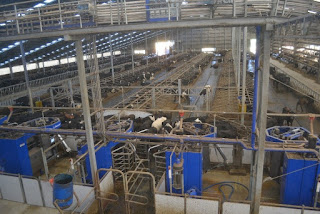Today we started out at the Hawkes
Bay Farmer Market. There were many different types of venues which included
fresh produce, a variety of meats, and fresh cooked treats. We indulged in
multiple treats including pastries, hot drinks, and fresh sandwiches. Plenty of
us spent some money on some fresh produce and wish we could stop at more in New
Zealand.
 |
| Cody
and Sam interact with the red deer. |
After the farmer’s market, we made
a short trek to Daniel Spiers who works with Maranoa Deer. Daniel has red deer
primarily but also Freisian Bulls. The property is about 300 Ha developed for
the deer in 1978. It is divided up to 62 paddocks for the deer and bulls to
rotate through 604 hinds (females) and 647 stags (males). The primary industry is
for venison, but they also have a side market for velvet production. Velvet
production is primarily sent to Korea for medicinal purposes. The growth for
velvet is from September to November, and two months later (January), the
velvet is harvested. The harvest is considered a food product so the process is
sterile and humane. The harvest produces about 1.6 ton annually. Venison in New
Zealand is sent to the United States or sent to be processed such as cat and
dog food. An average butcher weight is 115 kilograms for stags and 100
kilograms for hinds.
 |
| Students
take a closer look at velvet antlers at Daniel Spiers’ place. |
 |
| The
group at Coleman’s property enjoying the views. |
 |
|
Watching the sheep being herded by the dogs.
|
Next, we ventured out to Garth and
Wesley Coleman’s operation of Texel Fin NZ Romney sheep and Freisian bulls. We
started out our adventure with a hike up a slippery slope to view the property.
All of us were impressed with the views and what Garth shared with us about the
operation. They winter 1,690 ewes plus replacements and 282 bulls between
ninety paddocks on 294 hectares. The major goal for many farmers in New Zealand
is to be environmentally conscious and the Coleman’s have a plan in place to
prevent erosion. Other plans include fencing away livestock away from waterways
to prevent pollution. Goals that they have for their operation also include
roof over sheep yards, new drainage tiles, and to enjoy farming at their age.
We were also able to meet their daughter who is currently finishing her
doctorate in Animal Science. The Coleman’s then treated us to a wonderful home
cooked meal. The meal started off with rolls with pumpkin and kumara (sweet
potato) soup. The main course included steamed rice with venison casserole,
roasted lamb, veggies with cheese sauce, green beans, and coleslaw. We finished
out the meal with Pavlova and honeycomb ice cream. After the meal, we ventured
out again and were able to see the herding dogs in action. We then toured the
wool shed were we learned a bit more how they shear the sheep on the farm.
The next part of our day consisted
of traveling to Marton to meet our farmstay hosts for the evening. We enjoyed
the scenery and we saw a familiar view of wind turbines.
 |
| A
familiar site of wind turbines in New Zealand |
Kasey & Shawn









Comments
Post a Comment